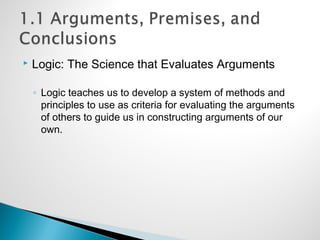
Chapter 01 hurley 12e
- 1. Logic: The Science that Evaluates Arguments ◦ Logic teaches us to develop a system of methods and principles to use as criteria for evaluating the arguments of others to guide us in constructing arguments of our own.
- 2. The Nature of Arguments: Premises and Conclusions ◦ An argument is a group of statements, one or more of which (the premises) are claimed to provide support for, or reasons to believe, one of the others (the conclusion).
- 3. Premise Indicators and Conclusion Indicators ◦ Some typical conclusion indicators: therefore, accordingly, entails that, etc. ◦ Some typical premise indicators: since, in that, seeing that, etc.
- 4. Typical structure of premises and conclusions:
- 5. Arguments vs. Nonarguments ◦ At least one statement must claim to present evidence or reasons. ◦ The alleged evidence must claim to support or imply something.
- 6. Simple Noninferential Passages: Basic Nonarguments ◦ Warning ◦ Piece of advice ◦ Statement of belief or opinion ◦ Report ◦ Loosely associated statements Expository Passages: Proof vs. Elaboration
- 7. Illustrations: Aid in Exemplification
- 8. Explanations: “Why Something is the Case” vs. “That Something is the Case” ◦ Golf balls have a dimpled surface because dimples reduce air drag, causing the ball to travel farther.
- 9. Conditional Statements by Themselves Are Not Arguments ◦ If professional football incites violence in the home, then we should reconsider giving widespread approval to the sport.
- 10. Deduction and Induction: Necessity vs. Probability ◦ Deductive arguments incorporate the claim that it is impossible for the conclusion to be false if the premises are true. ◦ Inductive arguments claim that it is improbable that the conclusion be false if the premises are true.
- 11. Common Types of Deductive Arguments: Based on Mathematics, From Definition, Categorical, Hypothetical and Disjunctive Syllogisms ◦ Example: Meerkats are members of the mongoose family. All members of the mongoose family are carnivores. Therefore, it necessarily follows that the meerkat is a carnivore.
- 12. Common Types of Inductive Arguments: Prediction, Analogy, From Authority, Based On Signs, Causal Inference ◦ Example: The meerkat is closely related to the suricat. The suricat thrives on beetle larvae. Therefore, probably the meerkat thrives on beetle larvae.
- 13. Valid vs. Invalid Deductive Arguments ◦ Valid deductive arguments are arguments in which it is impossible for the conclusion to be false given that the premises are true. ◦ Invalid deductive arguments are arguments in which it is possible for the conclusion to be false given that the premises are true.
- 14. Soundness: Validity plus all true premises Sound Argument = Valid argument + All true premises Example: All flowers are plants. All daisies are flowers. Therefore, all daisies are plants.
- 15. Strong vs. Weak Inductive Arguments ◦ Strong inductive arguments are arguments in which it is improbable that the conclusion is false given that the premises are true. In such arguments, the conclusion does probably follow from the premises. ◦ Conversely, a weak inductive argument is an argument in which the conclusion does not follow probably from the premises, even though it is claimed to.
- 16. Cogent Argument = Strong Argument + All true premises ◦ Example: Every previous U.S. president was older than 40. Therefore, probably the next U.S. president will be older than 40.
- 17. Form as determinative of validity ◦ All valid arguments take this form: All a are b. All c are a. All c are b.
- 18. Creating a Substitution Instance All a are b. All sporting events are engaging pastimes. All c are a. All baseball games are sporting events. All c are b. All baseball games are engaging pastimes. This argument is a substitution instance of the argument form. Any substitution instance of a valid argument form is a valid argument.
- 19. The Counterexample Method 1. Isolate the form All migratory waterfowl are birds that fly south for the winter. All geese are migratory waterfowl. Therefore, all geese are birds that fly south for the winter.
- 20. 2. Construct a Substitution Instance with true premises and a false conclusion The form of the argument is All a are b. All c are a. All c are b.
- 21. This form is identical to the form we just considered and is valid. ◦ Now consider an invalid argument form: All a are b. All c are b. All a are c.
- 22. Vertical Patterns: Conclusions subsequently become premises ◦ The vertical pattern consists of a series of arguments in which a conclusion of a logically prior argument becomes a premise of a subsequent argument.
- 23. Horizontal Patterns: When separate premises independently support a conclusion ◦ The horizontal pattern consists of a single argument in which two or more premises provide independent support for a single conclusion. If one premise was omitted, the other(s) would continue to support the conclusion in the same way.
- 24. Conjoint Premises: When separate premises can only support a conclusion together ◦ These premises depend on one another so closely that if one were omitted, the support that the others provide would be diminished or destroyed.
- 25. Multiple Conclusion: When a premise supports more than one conclusion in a passage ◦ Although no single argument can have more than one conclusion, we evaluate such passages as consisting of two or more arguments, but we join the two conclusions with a bracket.